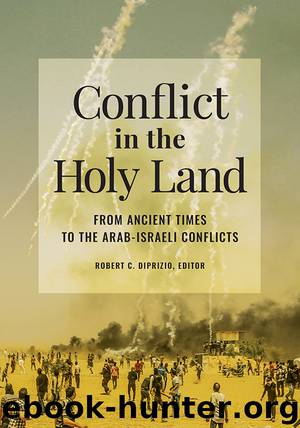Conflict in the Holy Land: from Ancient Times to the Arab-Israeli Conflicts by DiPrizio Robert C.;

Author:DiPrizio, Robert C.;
Language: eng
Format: epub
Publisher: ABC-CLIO, LLC
HISTORY OF JUDAISM
Judaism dates back to about 2000 BCE, when God made a covenant with Abraham that in exchange for obedience, he would become the father of a great nation that will live in “a land of milk and honey” (aka the Promised Land, the borders of which are nebulous but include what we now call Israel/Palestine) that will be protected by God. Drought forced Abraham’s descendants to roam northern Arabia for years until they were enslaved by Egyptian pharaohs.
In the thirteenth century BCE, Moses emerged as a leader to guide the Jews out of enslavement and back to the Promised Land, which had become occupied by the Canaanites. Moses led the Jews through the Sinai Desert. At Mount Sinai, he climbed to the top of the mountain to meet with God, who initiated a covenant with the Jewish people consisting of the Ten Commandments. Because the covenant was accepted by the Jewish people, all Jewish descendants are bound to it.
The commandments are the basic ethical code of Judaism. They include pronouncements not to kill, commit adultery, steal, bear false witness, use God’s name in vain, worship any likeness of God, or covet one’s neighbor’s possessions or wife. In addition, God invoked Jews to worship Him as the sole god, to honor one’s father and mother, and to keep the Sabbath as a day of rest once a week. So long as the Jews abided by these commandments, God would protect them and assure them prosperity.
After forty years, the Jews finally crossed the Jordan River under the leadership of Joshua. Their arrival coincided with the arrival of the Philistines, a seafaring tribe that also envisioned their future in the land occupied by the Canaanites. The three groups struggled for domination for more than 200 years, until King David prevailed and established a Jewish kingdom. His son and successor, Solomon, built a great temple in Jerusalem. Before long, however, the kingdom collapsed and divided into two parts. In both of the divided kingdoms, Jews strayed from worshipping only Yahweh despite the pleas of the Jewish prophets, who condemned the occultism and illicit behaviors of their brethren. The prophets took on the responsibility for the character of the Jewish religion. They equated human conduct to ethical principles and moral obligations and claimed that good conduct was more important than fulfilling religious ceremony. They stressed the inward quality of religion as a personal relationship between the individual and God.
In the sixth century BCE, the ruling Babylonians exiled the Jews three times, the most important of which took place in 587, when the Babylonians destroyed the Temple of Solomon. Those exiles marked the beginning of the diaspora, the scattering of Jews throughout the world.
In 538, nearly fifty years after the temple was destroyed, the Persian king Cyrus the Great allowed the Jews back to Jerusalem, where they built a new temple. Under the leadership of Nehemiah and Ezra, a Jewish theocratic state was created in the fifth century BCE, which ruled according to the dictates of the Torah.
Download
This site does not store any files on its server. We only index and link to content provided by other sites. Please contact the content providers to delete copyright contents if any and email us, we'll remove relevant links or contents immediately.
| Africa | Americas |
| Arctic & Antarctica | Asia |
| Australia & Oceania | Europe |
| Middle East | Russia |
| United States | World |
| Ancient Civilizations | Military |
| Historical Study & Educational Resources |
Empire of the Sikhs by Patwant Singh(22762)
The Wind in My Hair by Masih Alinejad(4839)
The Templars by Dan Jones(4556)
Rise and Kill First by Ronen Bergman(4543)
The Rape of Nanking by Iris Chang(4021)
12 Strong by Doug Stanton(3418)
Blood and Sand by Alex Von Tunzelmann(3055)
The History of Jihad: From Muhammad to ISIS by Spencer Robert(2504)
Babylon's Ark by Lawrence Anthony(2427)
The Turkish Psychedelic Explosion by Daniel Spicer(2245)
No Room for Small Dreams by Shimon Peres(2235)
Gideon's Spies: The Secret History of the Mossad by Gordon Thomas(2230)
Inside the Middle East by Avi Melamed(2230)
Arabs by Eugene Rogan(2193)
The First Muslim The Story of Muhammad by Lesley Hazleton(2153)
Bus on Jaffa Road by Mike Kelly(2034)
Come, Tell Me How You Live by Mallowan Agatha Christie(2024)
Kabul 1841-42: Battle Story by Edmund Yorke(1921)
1453 by Roger Crowley(1879)
